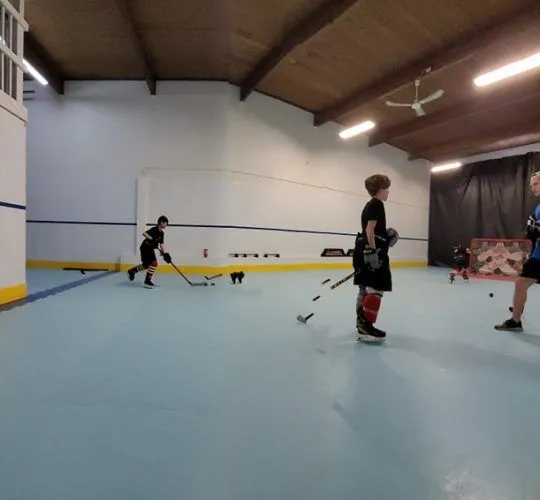Training is the backbone of any successful hockey team, whether at the youth, amateur, or professional level. Hockey is an intense and physically demanding sport that requires players to develop a unique blend of skills, stamina, and strategic understanding. To succeed on the ice, hockey team training must encompass multiple aspects of physical conditioning, technical skills, team coordination, and mental toughness. This holistic approach ensures that players are not only ready to compete but also capable of enduring the physical rigors of the sport while maintaining focus and sharpness throughout a game or season.

Physical Conditioning
At the core of every training program is physical conditioning. Hockey is played on an ice rink, which introduces an added layer of difficulty compared to many other sports. Skating, the primary means of movement in hockey, is physically taxing. It requires lower body strength, balance, and endurance. As a result, a significant portion of team training is focused on building leg strength, explosive power, and cardiovascular endurance.
Players engage in various off-ice exercises such as squats, lunges, plyometrics, and sprinting drills to strengthen their legs and improve their speed. Aerobic and anaerobic conditioning are equally important, as the sport involves bursts of high-intensity effort, followed by periods of lower activity. Training programs often include interval training, cycling, or running exercises that mimic the stop-and-start nature of hockey.
Core strength is also a major focus, as it helps players maintain balance on the ice, absorb checks, and generate powerful shots. Planks, Russian twists, and medicine ball exercises are common in hockey workouts. The upper body should not be neglected either—push-ups, pull-ups, and bench presses help players develop the strength needed to protect the puck, battle along the boards, and deliver accurate passes or shots.
On-ice conditioning is also critical. Speed drills, skating laps, and agility exercises help players develop stamina and skating technique. Skating at top speed while controlling the puck is a fundamental skill, and it requires hours of practice. Coaches often set up obstacle courses with cones or other markers to work on quick turns, acceleration, and maneuverability, ensuring players are agile and able to react swiftly during game situations.
Technical Skill Development
Hockey is not just about brute strength or speed; it’s a game of skill, requiring finesse in stickhandling, shooting, passing, and positioning. Stickhandling, or controlling the puck, is one of the most important skills in hockey. Players must be able to handle the puck confidently in tight spaces, while skating at high speeds, and under pressure from opposing defenders. To improve stickhandling, players participate in drills that emphasize control, such as weaving through cones or working on puck possession in small-area games.
Shooting is another essential skill, and players spend a great deal of time perfecting different types of shots—wristers, slap shots, snap shots, and backhands. Each requires a different technique, but all demand proper form, strength, and accuracy. Coaches often emphasize quick release, as the ability to shoot fast and without hesitation is crucial in game situations. Players also practice aiming for the corners of the net, or “picking corners,” to improve their scoring chances against goaltenders.
Passing is equally vital, especially in a sport as fast-paced as hockey, where team coordination can make the difference between a successful play and a missed opportunity. Players practice passing while skating at full speed to simulate game scenarios. Quick, accurate passing is essential for setting up scoring opportunities and breaking through defensive formations. Coaches frequently organize passing drills that focus on one-touch passing and cross-ice passes to improve accuracy and timing.
In addition to individual technical skills, players must develop a strong understanding of their positioning on the ice. Training sessions often involve scrimmages and positional drills, where players learn where to be in both offensive and defensive situations. Proper positioning allows players to intercept passes, make smart defensive plays, or capitalize on scoring opportunities. Defensive players, in particular, focus on maintaining good gap control and knowing when to engage opponents or retreat to defend the goal.
Teamwork and Communication
While individual skills are essential, hockey is ultimately a team sport, and success on the ice requires effective teamwork and communication. Hockey team training involves plenty of scrimmage time and drills designed to promote team chemistry and understanding. Each line of players must function as a cohesive unit, with forwards, defensemen, and goaltenders working together to execute plays and defend against the opposing team.
Communication on the ice is key, and players are encouraged to constantly talk to each other—calling for passes, alerting teammates to incoming defenders, or signaling for a line change. Teams also practice specific systems and strategies during training, such as forechecking, backchecking, and the power play. Understanding these systems and being able to execute them effectively under pressure requires repetition and focus.
Forechecking drills help players learn how to pressure the opposing team in their defensive zone, forcing turnovers and creating offensive opportunities. Backchecking, on the other hand, teaches forwards and defensemen how to quickly transition from offense to defense, tracking back to prevent odd-man rushes. Power play and penalty-killing units also spend a significant amount of time practicing, as special teams often play a pivotal role in deciding the outcome of games.
Coaches play an important role in fostering teamwork by encouraging unselfish play, emphasizing the importance of passing over taking low-percentage shots, and promoting a mindset of playing for the team rather than individual glory. This kind of training builds camaraderie and trust, both of which are critical for success during games, when split-second decisions and instinctual play are paramount.
Mental Toughness and Preparation
In addition to physical conditioning and skill development, mental preparation is a crucial part of hockey team training. Hockey is an intense, fast-paced sport that requires quick thinking, resilience, and the ability to stay calm under pressure. Players need to be mentally sharp and focused throughout an entire game, which can often last well over an hour.
Visualization is one technique commonly used in hockey training to improve mental toughness. Players are encouraged to mentally rehearse specific game situations—such as taking a shot, defending a breakaway, or executing a specific play—before they happen. This helps players build confidence and prepares them to react instinctively during games. Mental toughness also involves handling the physical and emotional demands of the sport, such as staying composed after making a mistake or bouncing back from a tough loss.
Coaches may incorporate sports psychology techniques into training sessions to help players develop coping strategies for dealing with stress, fatigue, and adversity. Breathing exercises, meditation, and focus drills are some methods used to enhance players’ concentration and reduce anxiety. Building mental resilience is essential in a sport where players are expected to endure hard hits, physical exhaustion, and high-pressure situations.
Recovery and Injury Prevention
With the high physical demands placed on players during training, recovery and injury prevention are critical aspects of a successful training program. Stretching, mobility work, and rest are key components to ensure players stay healthy throughout the season. Dynamic stretching before training sessions or games helps warm up muscles and prepare the body for intense activity, while static stretching post-session aids in recovery and flexibility.
Strength and conditioning coaches often emphasize mobility exercises that improve joint health and reduce the risk of injury. Foam rolling, yoga, and targeted strength exercises can help prevent common hockey injuries like groin strains, knee injuries, or concussions. Recovery protocols also include proper nutrition, hydration, and sleep, all of which contribute to optimal performance and quicker recovery times.
The training regimen for a hockey team is rigorous and multifaceted. It goes far beyond simple drills or game simulations, involving physical conditioning, technical skill development, teamwork, mental preparation, and injury prevention. Each of these elements contributes to building a successful team, capable of withstanding the demands of a long season and the pressures of competition. By embracing a holistic approach to training, players can not only improve their performance but also foster the resilience and camaraderie needed to succeed as a team.




